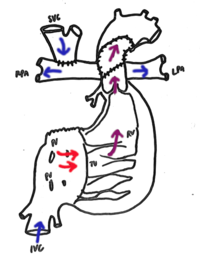
Photo from wikipedia
Abstract Fibromyalgia (FM) tends to coexist with gastroesophageal reflux disease (GERD). This retrospective cohort study was conducted to determine the bidirectional association between FM and GERD, using a nationwide database,… Click to show full abstract
Abstract Fibromyalgia (FM) tends to coexist with gastroesophageal reflux disease (GERD). This retrospective cohort study was conducted to determine the bidirectional association between FM and GERD, using a nationwide database, the National Health Insurance of Taiwan. We established 2 study arms, including 35,117 patients with FM in arm 1 and 34,630 patients with GERD in arm 2, newly diagnosed between 2000 and 2010. For each study arm, we randomly selected 4-fold subjects with neither FM nor GERD from the same database, frequency matched by sex, age, and diagnosis date, as the respective control cohorts. Incidence of GERD in arm 1 and incidence of FM in arm 2 were estimated by the end of 2011. The overall incidence of GERD was 1.6-fold greater in the FM cohort than in the non-FM cohort (12.0 and 7.61 per 1000 person-years, crude hazard ratio [HR] = 1.58, 95% confidence interval [CI] = 1.51-1.66), with an adjusted HR (aHR) of 1.27 (95% CI = 1.22-1.33) after controlling for sex, age, comorbidities, and medications. The GERD cohort ultimately had a 1.5-fold higher incidence of FM than the non-GERD cohort (5.76 vs 3.96 per 1000 person-years), with an aHR of 1.44 (95% CI = 1.29-1.60). The present study suggests a bidirectional relationship between FM and GERD. There is a greater risk of developing GERD for patients with FM than developing FM for patients with GERD.
Journal Title: PAIN
Year Published: 2017
Link to full text (if available)
Share on Social Media: Sign Up to like & get
recommendations!